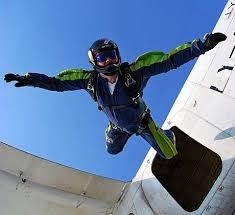Skydiving Safety Rules

Skydiving is a thrilling way for people to experience the sensation of flight. However, since there are definite risks involved, strict adherence to safety rules and procedures is crucial. Failure to follow the rules laid out for you by your skydiving instructor can be a matter of life or death. Because beginning skydivers will dive in tandem with an instructor, proper safety precautions are vital to ensure your instructor's safety as well.
General Safety Procedures
Before the jump even begins, you must communicate with the other people in your jumping party. If several people are jumping, you must decide a jump order and ensure that the proper distance exists between you and the previous jumper. For first-time jumpers, listening to your instructor is the most important thing you can do. You will probably be fairly nervous and as a result may act on impulse. Your instructor had to go through rigorous safety training so trust what he/she says and follow his/her lead before, during and after the jump.
Parachute Deployment
If you are an experienced skydiver, you should deploy your parachute when you are 600 meters (1,970 feet) or more from the ground. Early deployment is necessary should your main parachute not open. Before deployment, skydivers must verify that there are not other deployed parachutes in the immediate vicinity. Should you find yourself on a collision course, wait until your parachute is fully deployed and then steer away from the collision with your rear riser. If the collision is head-on, turn right. Since your right and the right of the person you are on a collision course with are on opposite sides, this will ensure that you avoid a collision.
Post-Deployment
Many skydiving fatalities result from reckless maneuvers once the parachute has deployed. Referred to as "hook turns" and "swoops," these "diving" techniques give divers a thrilling jolt but also open up the possibility of high-speed impacts with the ground. Swoops are designed to delay speed reduction until the last possible moment. Although experienced divers can execute swoops and hook turns safely, the possibility of misjudging altitude, landing angle or speed is simply too dangerous to risk. Low-hook turns are strictly forbidden at many skydiving centers around the country.
Landing
Skydiving jump runs have predetermined landing patterns to ensure divers' safety. Since many people jump as groups, you must make sure you stick with your group and follow the lead of the first lander. If the conditions are windy, do not land in the same direction as the first lander in case the wind blows you towards him/her. However, on a no-wind day, follow the leader's direction.
General Safety Procedures
Before the jump even begins, you must communicate with the other people in your jumping party. If several people are jumping, you must decide a jump order and ensure that the proper distance exists between you and the previous jumper. For first-time jumpers, listening to your instructor is the most important thing you can do. You will probably be fairly nervous and as a result may act on impulse. Your instructor had to go through rigorous safety training so trust what he/she says and follow his/her lead before, during and after the jump.
Parachute Deployment
If you are an experienced skydiver, you should deploy your parachute when you are 600 meters (1,970 feet) or more from the ground. Early deployment is necessary should your main parachute not open. Before deployment, skydivers must verify that there are not other deployed parachutes in the immediate vicinity. Should you find yourself on a collision course, wait until your parachute is fully deployed and then steer away from the collision with your rear riser. If the collision is head-on, turn right. Since your right and the right of the person you are on a collision course with are on opposite sides, this will ensure that you avoid a collision.
Post-Deployment
Many skydiving fatalities result from reckless maneuvers once the parachute has deployed. Referred to as "hook turns" and "swoops," these "diving" techniques give divers a thrilling jolt but also open up the possibility of high-speed impacts with the ground. Swoops are designed to delay speed reduction until the last possible moment. Although experienced divers can execute swoops and hook turns safely, the possibility of misjudging altitude, landing angle or speed is simply too dangerous to risk. Low-hook turns are strictly forbidden at many skydiving centers around the country.
Landing
Skydiving jump runs have predetermined landing patterns to ensure divers' safety. Since many people jump as groups, you must make sure you stick with your group and follow the lead of the first lander. If the conditions are windy, do not land in the same direction as the first lander in case the wind blows you towards him/her. However, on a no-wind day, follow the leader's direction.
- eccfc9287822016d098ce3b12353eb0cca.jpg